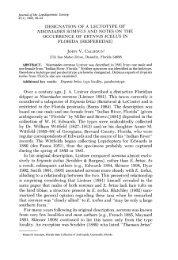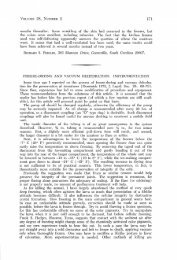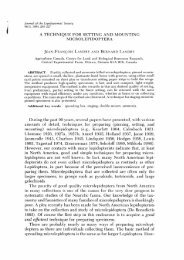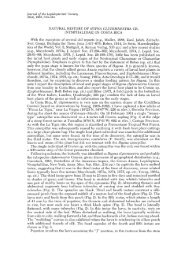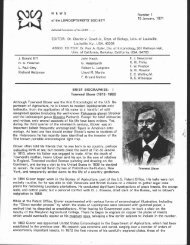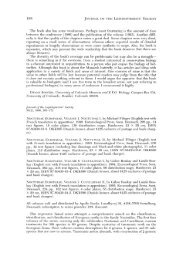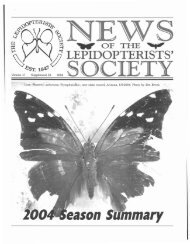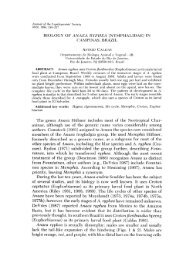Notes on the life cycle and natural history of butterflies of El Salvador ...
Notes on the life cycle and natural history of butterflies of El Salvador ...
Notes on the life cycle and natural history of butterflies of El Salvador ...
Create successful ePaper yourself
Turn your PDF publications into a flip-book with our unique Google optimized e-Paper software.
310 JOURNAL OF THE LEPIDOPTERISTS' SOCIETY<br />
brown. Females usually larger than males; average, from tip to tip <strong>of</strong> spread forewings,<br />
5.5 em in female, <strong>and</strong> 5.0 em in male. Total developmental time from 40-45<br />
days.<br />
Natural History<br />
During <strong>the</strong> five years we have been observing <strong>and</strong> rearing this species<br />
we have seen <strong>the</strong> females lay eggs <strong>on</strong> two species <strong>of</strong> Crot<strong>on</strong> (Euphorbiaceae):<br />
C. reflexifolius H. B. K., <strong>and</strong>, more rarely, C. niveus Jacquin.<br />
These species are very similar, <strong>and</strong> are known by <strong>the</strong> comm<strong>on</strong> name,<br />
CopalchL The most apparent difference is that <strong>the</strong> fruits <strong>of</strong> C. reflexifolius<br />
are muricated, but are not in C. niveus. Both species grow to small<br />
tree size (about 6 m) <strong>and</strong> both are used comm<strong>on</strong>ly to form wind-break<br />
barriers in c<strong>of</strong>fee plantati<strong>on</strong>s (due to <strong>the</strong>ir thick foliage) <strong>and</strong> for fence<br />
supports. The leaves <strong>and</strong> bark <strong>of</strong> both species are very aromatic <strong>and</strong><br />
bitter, <strong>and</strong> are widely used in popular medicines as infusi<strong>on</strong>s against<br />
fevers <strong>and</strong> to aromaticize alcoholic beverages. Both species keep <strong>the</strong>ir<br />
leaves year around.<br />
We have found in <strong>the</strong> literature (Planch<strong>on</strong> & Collin, 1895) <strong>the</strong> following<br />
<strong>on</strong> C. niveus: "J. <strong>El</strong>liot Howard a signaIe dans cette ecorce une<br />
matiere amere soluble dans l'e<strong>the</strong>r, qui au c<strong>on</strong>tact du chlore et de<br />
l'am<strong>on</strong>iaque prend une teinte vert f<strong>on</strong>ce. Moench n'a pu y c<strong>on</strong>s tater la<br />
presence d'un alcalolde; il en a seulement retire une huile essentielle<br />
c<strong>on</strong>stituee par un hydrocarbure, un acide organique et un principe amer<br />
cristallisable, la Copalchine, soluble dans l'alcool et Ie chlor<strong>of</strong>orme."<br />
Calder<strong>on</strong> y St<strong>and</strong>ley (1941) state about C. reflexifolius, "La hojas y<br />
frutas s<strong>on</strong> muy aromaticas; las hojas utilizadas en la c<strong>on</strong>fecci<strong>on</strong> de algunos<br />
aguardientes; la corteza como febrifugo y remedio t<strong>on</strong>ico."<br />
The recently emerged larvae completely devour <strong>the</strong> egg shell <strong>and</strong> stay<br />
under <strong>the</strong> leaf without fur<strong>the</strong>r eating for about <strong>on</strong>e day, moving afterwards<br />
to <strong>the</strong> border <strong>of</strong> <strong>the</strong> leaf, usually to <strong>the</strong> tip, where <strong>the</strong>y choose a<br />
terminal vein which <strong>the</strong>y eat around <strong>and</strong> bare. Using excreta stuck with<br />
silk <strong>the</strong>y prol<strong>on</strong>g <strong>the</strong> vein <strong>and</strong> use this as a resting place while not feeding,<br />
<strong>the</strong> head usually pointing outward. The larvae during <strong>the</strong> first, sec<strong>on</strong>d<br />
<strong>and</strong> third stadia ab<strong>and</strong><strong>on</strong> this perch <strong>on</strong>ly for feeding purposes. During<br />
<strong>the</strong> fourth stadium <strong>the</strong> larvae w<strong>and</strong>er about <strong>the</strong> plant for a short time<br />
until <strong>the</strong>y select a bigger leaf, where <strong>the</strong>y form a funnel-like refuge by<br />
rolling <strong>the</strong> leaf with <strong>the</strong> help <strong>of</strong> silk to crawl back into. From <strong>the</strong>n until<br />
pupati<strong>on</strong> <strong>the</strong> larvae keep hiding inside this funnel, leaving it momentarily<br />
<strong>on</strong>ly for feeding, which is d<strong>on</strong>e at dawn <strong>and</strong> dusk. The thick <strong>and</strong> tuberclad<br />
head is very effective in blocking <strong>the</strong> entrance against any predator<br />
or injecti<strong>on</strong>-parasite. The excrements are expelled through <strong>the</strong> narrow<br />
end <strong>of</strong> <strong>the</strong> funnel.





